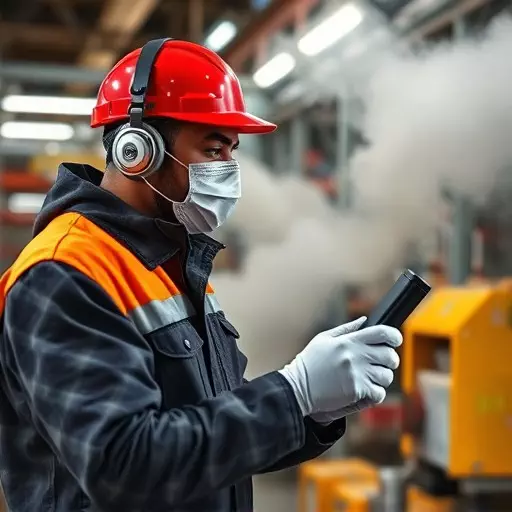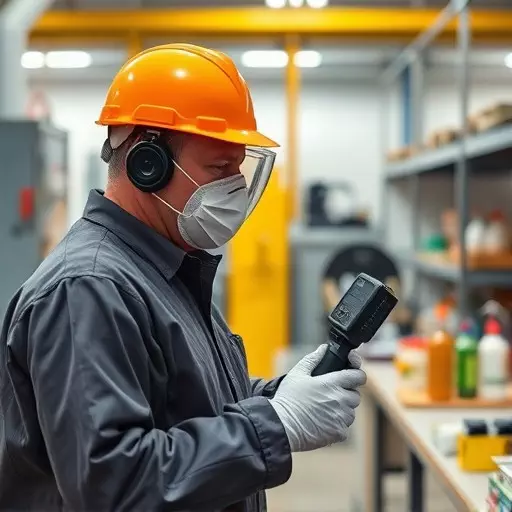Hazardous substance monitoring protects employees and maintains safe workplaces by identifying, assessing, and mitigating risks from toxic materials. This involves regular employee exposure monitoring and workplace air quality testing to ensure compliance with safety regulations and prioritize workforce health. Key processes include identifying substances, evaluating their health effects, implementing control measures (e.g., improved ventilation, PPE), and utilizing advanced analytical techniques for effective risk management, ultimately enhancing productivity and workplace safety.
In today’s industrial landscape, hazardous substance monitoring is paramount for ensuring worker safety and environmental protection. This comprehensive guide delves into the critical aspect of understanding, implementing, and maintaining effective monitoring strategies. From employee exposure monitoring to workplace air quality testing, each section provides insights into assessing and mitigating risks associated with hazardous substances. By adhering to these practices, organizations can foster a safer, healthier work environment.
- Understanding Hazardous Substance Monitoring: A Comprehensive Overview
- Employee Exposure Monitoring: Protecting Workers' Health and Safety
- Workplace Air Quality Testing: Assessing the Risk of Hazardous Substances
- Implementing Effective Monitoring Strategies for a Safer Workplace
Understanding Hazardous Substance Monitoring: A Comprehensive Overview
Hazardous substance monitoring is a critical process aimed at safeguarding employees and maintaining optimal workplace conditions. It involves comprehensive strategies to identify, assess, and mitigate risks associated with toxic materials present in work environments. By implementing regular employee exposure monitoring and workplace air quality testing, organizations can ensure compliance with safety regulations and prioritize the health of their workforce.
This proactive approach includes identifying hazardous substances, evaluating their potential impacts on human health, and establishing control measures to minimize exposure. Through advanced analytical techniques and regulatory frameworks, employers can effectively manage risks, promote a safe working atmosphere, and foster a culture of well-being among employees.
Employee Exposure Monitoring: Protecting Workers' Health and Safety
Employee Exposure Monitoring plays a pivotal role in ensuring workers’ health and safety within facilities handling hazardous substances. It involves regular workplace air quality testing to gauge the presence and concentration of potentially harmful compounds in the atmosphere. By implementing such monitoring, organizations can identify risks associated with exposure to these substances, enabling them to take proactive measures for risk mitigation.
This process typically includes collecting samples from various work areas, analyzing them for specific hazardous materials, and using the data to inform workplace safety protocols. For instance, if testing reveals elevated levels of volatile organic compounds (VOCs) in a painting section, the company might introduce better ventilation systems or switch to less toxic paints, thereby safeguarding employees’ well-being and adhering to hazardous substance monitoring regulations.
Workplace Air Quality Testing: Assessing the Risk of Hazardous Substances
Workplace Air Quality Testing plays a pivotal role in Hazardous Substance Monitoring, serving as a critical tool to assess and mitigate risks for employee exposure. By measuring airborne concentrations of various chemicals, dusts, gases, and other contaminants, this testing provides invaluable insights into potential health hazards present in the work environment. It’s not just about identifying problematic substances; it involves quantifying their levels to ensure they fall within safe limits.
Regular workplace air quality assessments help employers implement effective control measures. This can include improving ventilation systems, introducing engineering controls, or enforcing strict personal protective equipment (PPE) protocols. Such proactive steps are essential in minimizing employee exposure and upholding a safe working atmosphere, thereby enhancing overall productivity and job satisfaction.
Implementing Effective Monitoring Strategies for a Safer Workplace
Implementing effective monitoring strategies is paramount for ensuring a safer workplace, especially when dealing with hazardous substances. Employee exposure monitoring plays a crucial role in identifying potential risks and mitigating them before they cause harm. Regular testing of air quality at the workplace is a fundamental step in this process. By measuring airborne contaminants, employers can pinpoint areas where hazardous substances may be present and take appropriate action to reduce employee exposure.
These strategies include implementing robust ventilation systems, providing personal protective equipment (PPE), and establishing strict protocols for handling and storing hazardous materials. Regular training sessions for employees on the proper use of PPE and safe work practices further enhance overall workplace safety. Additionally, conducting periodic hazard assessments helps in identifying new or previously overlooked substances that may pose risks, allowing for proactive measures to be taken.


